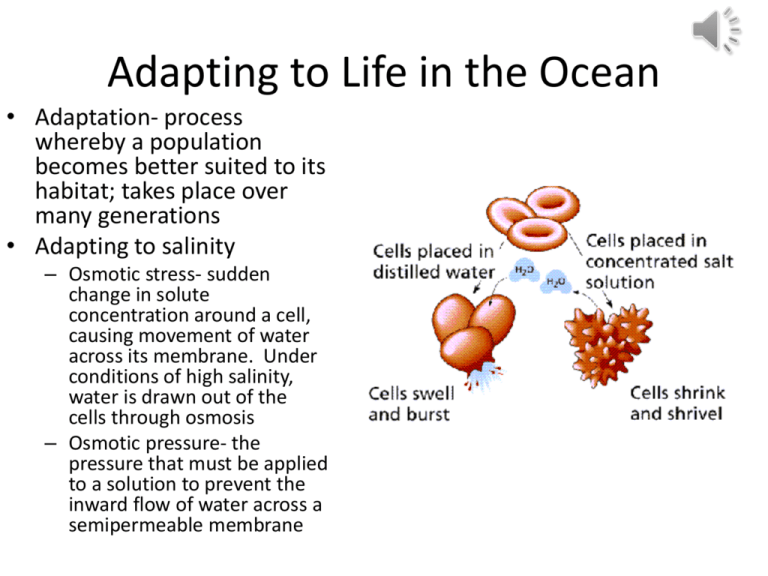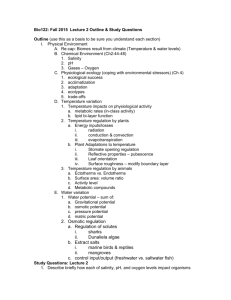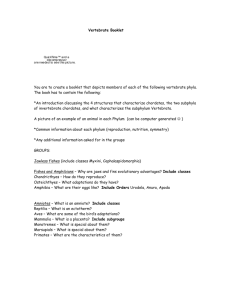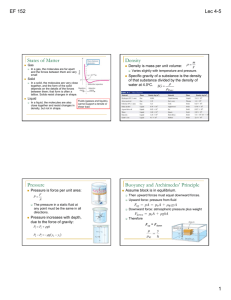Adapting to Life in the Ocean
advertisement

Adapting to Life in the Ocean • Adaptation- process whereby a population becomes better suited to its habitat; takes place over many generations • Adapting to salinity – Osmotic stress- sudden change in solute concentration around a cell, causing movement of water across its membrane. Under conditions of high salinity, water is drawn out of the cells through osmosis – Osmotic pressure- the pressure that must be applied to a solution to prevent the inward flow of water across a semipermeable membrane Osmoregulation- active regulation of osmotic pressure of an organism’s fluids to maintain water content; it keeps organism’s fluids from becoming too dilute or too concentrated – Osmoconformer- match their body osmolarity (salinity) to their environment – Osmoregulator- regulate their body osmolarity by actively controlling salt concentrations despite salt concentration of the environment • Osmoregulator – Stenohaline- restricted to either salt or fresh water and cannot survive in water with a different salt concentration than they are adapted to – Euryhaline- show a tremendous ability to effectively osmoregulate across a broad range of salinities • Adapting to temperature – Organisms lose heat more quickly in water than in air – Adaptations • Ectotherm/ poikilotherm- internal body temperature varies along with the ambient environmental temperature; dependent on environmental heat sources; relatively low metabolic rates (most fishes and reptiles) • Adaptations – Endotherm- internal body temp. varies but is elevated above ambient environmental temps as a result of metabolic heat production (some fishes) – Homeotherm- internal body temp. remains relatively constant despite the ambient environmental temp. (birds and mammals) • Adapting to viscosity – Viscosity – describes a fluid’s internal resistance to flow; water is “thin”, having a lower viscosity, while honey is “thick”, having a higher viscosity – Drag – refers to forces that oppose the relative motion of an object through a fluid – Hydrodynamic adaptations • Fusiform- body shape characterized by being tapered at both the head and the tail • Fish secrete mucous from glands under their skin; reduces drag by 60% • Sharks have denticles on their skin that cause the water to form a thin film that reduces drag in much the same way as the slimy mucous • Adapting to pressure – Hydrostatic pressurepress. At a given depth in a static liquid is a result of the weight of the liquid acting on a unit area at that depth plus any pressure acting on the surface liquid – Pressure increases 1 atmosphere (or bar) for every 10 meter or 33 ft of depth in ocean water – Adaptations • Light skeletons and water muscles • Fluid filled body cavities rather than gas- filled spaces • Piezophile- organism that thrives at high pressures (deep sea bacteria or acrhaea) • Buoyancy- upward force, caused by fluid pressure that keeps things afloat – Archimedes’ principle- any object, wholly or partially immersed in a fluid, is buoyed up by a force equal to the weight of the fluid displaced by the object – Adaptations • Small size reduces sinking (plankton) • Using fins as hydrofoils (sharks) • Using low –density organic compounds (oil) or body fluids (plankton, sharks) • Gas- filled bladders (bony fishes)






